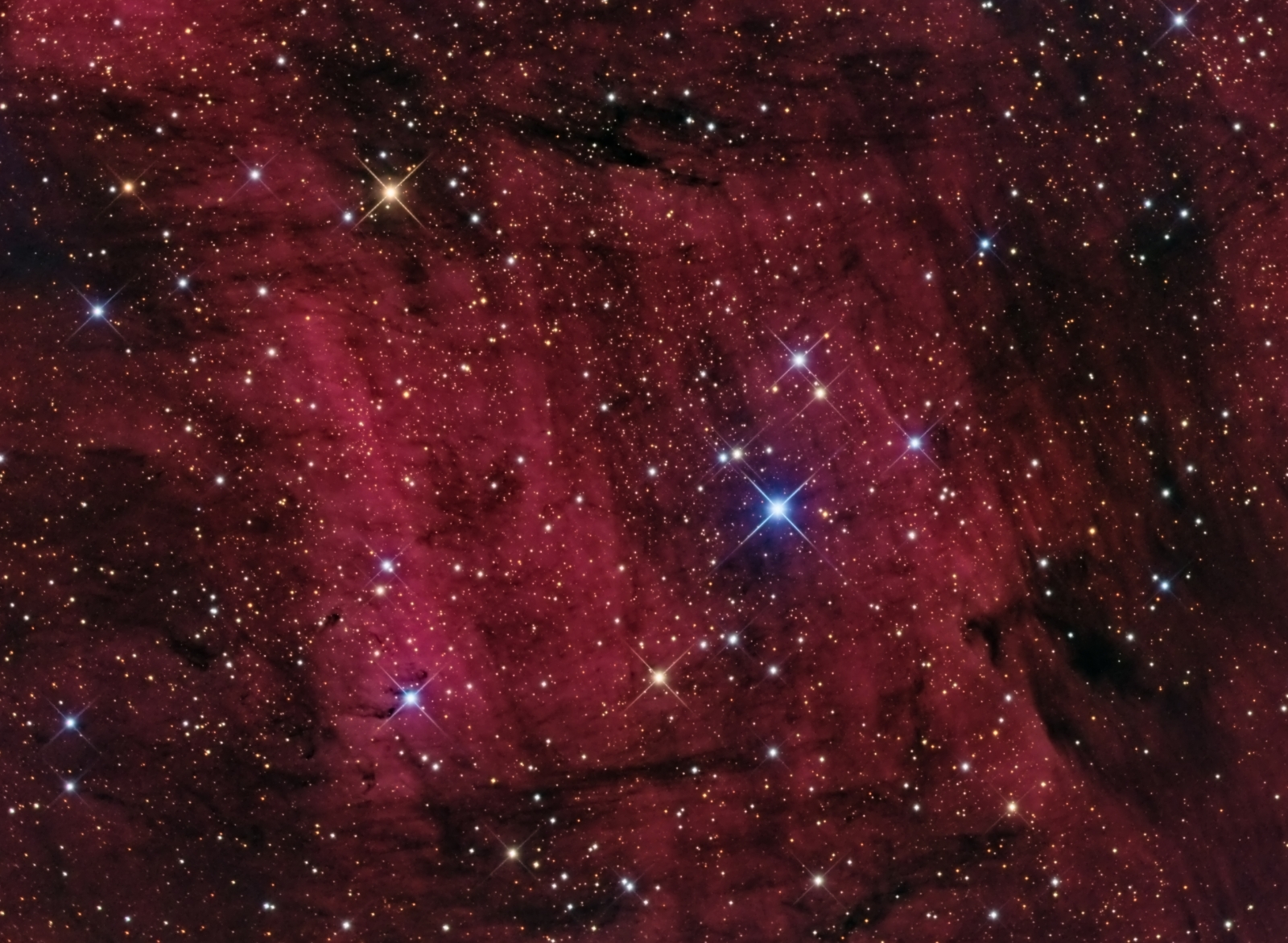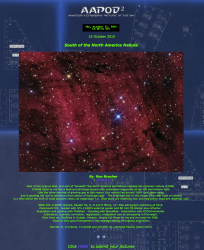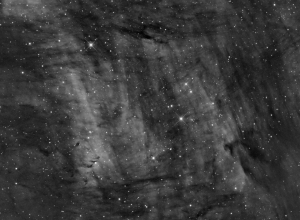IC5068 Emission Nebula
 Click image for full size version
Click image for full size version
August 11, 2015, Amateur Astronomy Picture of the Day October 15, 2015
 I am continuing to explore the area around the bright star Deneb and the North America nebula. East of the Cygnus Wall, and sort of “beneath” the North America and Pelican nebulae lies emission nebula Ic5068. IC5068 looks to me like a bent-out-of-shape square with extensions diagonally at top left and bottom right. Like the other patches of glowing gas in this region, this nebula lies around 1600 light years away, and is glowing red due to emissions from atoms of hydrogen gas. The brightest star in this image (blue star right of centre) is a little below the limit of most people’s vision, at magnitude 7.3. Blue stars are relatively hot, and red/yellow stars are relatively cool.
I am continuing to explore the area around the bright star Deneb and the North America nebula. East of the Cygnus Wall, and sort of “beneath” the North America and Pelican nebulae lies emission nebula Ic5068. IC5068 looks to me like a bent-out-of-shape square with extensions diagonally at top left and bottom right. Like the other patches of glowing gas in this region, this nebula lies around 1600 light years away, and is glowing red due to emissions from atoms of hydrogen gas. The brightest star in this image (blue star right of centre) is a little below the limit of most people’s vision, at magnitude 7.3. Blue stars are relatively hot, and red/yellow stars are relatively cool.
 The colour image above blends the red, green and blue channels with data collected through a deep red H-alpha filter that lets in just the light emitted by hydrogen atoms. The black and white image at right shows the H-alpha data alone; click on the image to see it full size. The eye is better at picking out detail in black and white images than colour images. The stars are smaller in the Ha version because most starlight is emitted at wavelengths other than H-alpha. The colour and mono versions complement each other, and I hope you enjoy them both.
The colour image above blends the red, green and blue channels with data collected through a deep red H-alpha filter that lets in just the light emitted by hydrogen atoms. The black and white image at right shows the H-alpha data alone; click on the image to see it full size. The eye is better at picking out detail in black and white images than colour images. The stars are smaller in the Ha version because most starlight is emitted at wavelengths other than H-alpha. The colour and mono versions complement each other, and I hope you enjoy them both.
Tekkies:
SBIG STL-11000M camera, Baader Ha, R, G and B filters, 10″ ASA astrograph operating at f/6.8, Paramount MX. Guided with STL-11000’s external guider and 80 mm f/6 Stellar-Vue refractor. Acquisition and guiding with TheSkyX. Focusing with FocusMax. Automation with CCDCommander. Calibration, cosmetic correction, registration, integration and all processing in PixInsight. Shot from my SkyShed in Guelph, Ontario. Nearly full Moon for Ha and no moon for RGB. Good to very good transparency and average seeing throughout acquisition.
18x15m R, 17x15mG, 17x15mB and 10x30m Ha unbinned frames (total=18hr).
HaRGB
Creation and cleanup: R, G and B masters were combined. The RGB ad Ha frames were cropped and processed separately with ABE. The RGB image which processed with ColorCalibration. The NB-RGBCombine Script was applied with default settings to produce a linear HaRGB image. PixelMath was used to boost the blue by adding 3% Ha.
Linear Noise Reduction: MultiscaleLinearTransform was used to reduce noise in the background areas. Layer settings for threshold and strength: Layer 1: 3.0, 0.5 Layer 2: 2.0, 0.35 Layer 3: 1.0, 0.2 Layer 4: 0.5, 0.1
Stretching: HistogramTransformation was applied to make a pleasing yet bright image. TGV Noise was applied and the image was re-stretched to reset the black point.
Synthetic Luminance and H-alpha only
Creation and cleanup: The cleaned up Ha, R,G and B masters were combined using the ImageIntegration tool (average, additive with scaling, noise evaluation, iterative K-sigma / biweight midvariance, no pixel rejection). The Ha master was copied, with the copy used for the Ha-only image.
The following steps were done in parallel on both the SynthL and Ha masters.
Deconvolution: A copy of the image was stretched to use as a deconvolution mask. A star mask was made from unstretched SynthL to use as a local deringing support. Deconvolution was applied (100 iterations, regularized Richardson-Lucy, external PSF made using DynamicPSF tool with about 20 stars; local deringing at 70% and global dark deringing at 0.02).
Linear Noise Reduction: MultiscaleLinearTransform was applied to reduce the noise. Layer settings for threshold and strength: Layer 1: 3.0, 0.5 Layer 2: 2.0, 0.35 Layer 3: 1.0, 0.2 Layer 4: 0.5, 0.1
Stretching: HistogramTransformation was applied to make a pleasing yet bright image. TGV Noise was applied and the image was re-stretched to reset the black point.
HDR Multiscale Transformation: HDRMT was applied at 6 and 4 pixel scales using a mask to protect stars. LHE was applied at scales of 50 and 150 using the same star mask (strength 0.25 for both).
Combining SynthL with HaRGB:
The luminance channel of the HaRGB image was extracted, processed and then added back into the HaRGB image as follows:
1. Extract luminance from the HaRGB image.
2. Apply LinearFit using SynthL as the reference.
3. Use ChannelCombination in Lab mode to replace the HaRGB’s luminance with the fitted luminance from step 2.
4. LRGBCombine was then used to make a SynthLHaRGB image.
Final Processing
HaRGB: Star shapes were smoothed and sizes reduced by applying MorphologicalTransformation through the same star mask using the Midpoint operator, with default settings. A light unsharp mask was then applied to the stars. A range mask for the brightest highlights minus stars was made by subtracting a star mask from a range mask. The highlights were sharpened slightly with unsharp mask. Overall contrast and brightness were increased slightly with the Curves tool.
Ha only: The highlights were sharpened slightly with unsharp mask. Overall contrast and brightness were increased slightly with the Curves tool.
Image scale is about 1.1 arcsec per pixel for this camera / telescope combination.






Excellent work Ron! Thank you for posting your processing details, very helpful!
Another top image – and thanks again for the processing detail
Mark